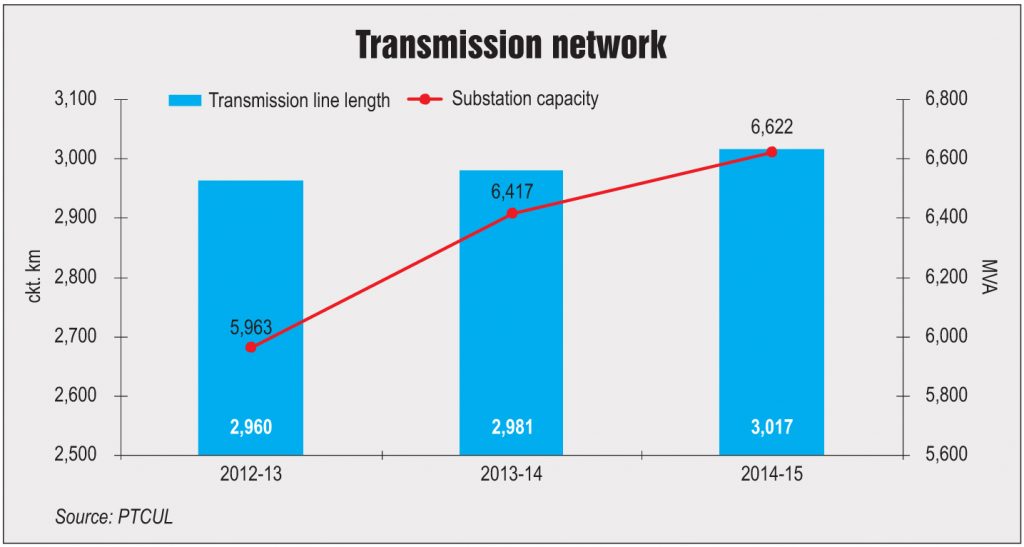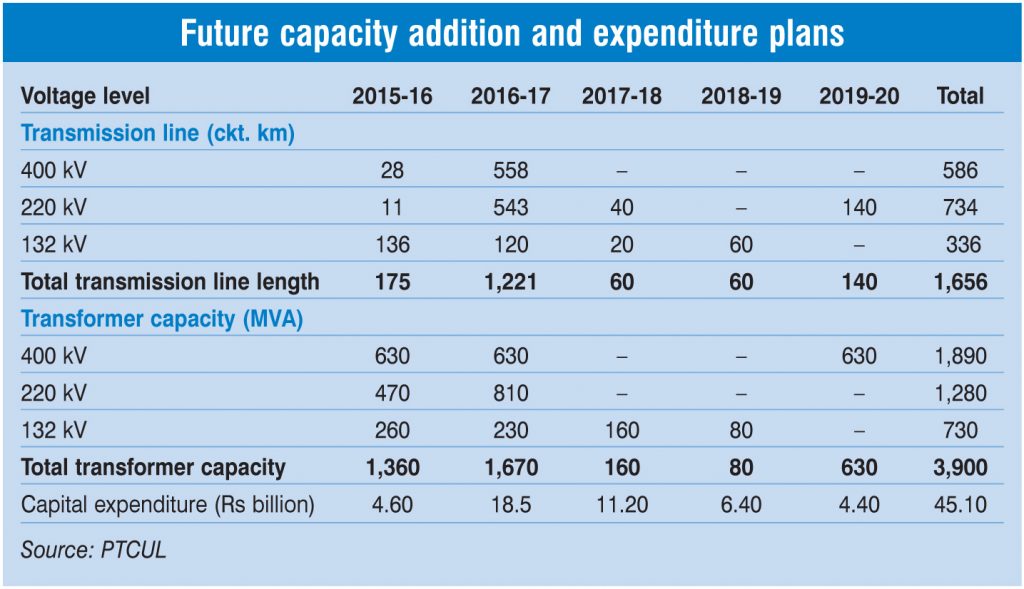Power Transmission Corporation of Uttarakhand Limited (PTCUL) was incorporated in 2004 to comply with the unbundling requirements of the Electricity Act, 2003. Prior to that, the transmission and distribution assets in the state were owned and operated by Uttarakhand Power Corporation Limited, which was set up following the creation of the new state of Uttarakhand in 2000.
PTCUL is responsible for operating, developing and maintaining the high voltage and extra high voltage transmission lines and substations in Uttarakhand along with performing the load despatch functions. Despite numerous challenges such as the unavailability of suitable land for substation construction, right-of-way problems in the construction of transmission lines, and the long and tedious process of land transfer and obtaining forest clearances, the utility’s performance in terms of network expansion and operational efficiency has been good in recent years. Its transmission availability has consistently remained above 99 per cent, while its transmission losses have been below 2 per cent.
With the aim of strengthening its network, PTCUL is looking at a significant investment of about Rs 45 billion in its transmission infrastructure over the next five years. Simultaneously, there is a strong focus on the deployment of IT solutions to enhance operational efficiency.
Transmission infrastructure
PTCUL’s transmission network comprises transmission lines and substations at the 400 kV, 220 kV and 132 kV levels. As of March 2015, its network comprised 3,017 ckt. km of transmission lines and 38 substations with a total transformation capacity of 6,622 MVA. However, as of February 2016, the utility had further augmented its transmission infrastructure to 3,192 ckt. km of transmission lines and 41 substations with a total transformation capacity of 8,022 MVA.
Between 2011-12 and 2014-15, PTCUL’s transmission line length grew from 2,790 ckt. km in 2011-12 to 3,017 ckt. km in 2014-15, marking a compound annual growth rate (CAGR) of 2.64 per cent. During the same period, while PTCUL’s line length at the 400 kV level remained stagnant, at the 220 kV level, it grew the fastest at 3.21 per cent. The transmission line network is skewed towards the 132 kV voltage level, which accounts for around 60 per cent (1,822 ckt. km) of the total line length. Meanwhile, lines at the 220 kV and 400 kV levels constitute about 27 per cent (807 ckt. km) and 13 per cent (388 ckt. km) respectively.
PTCUL’s substation capacity is concentrated at the 132 kV voltage level, which makes up 44 per cent (2,917 MVA) of the total capacity. Of the remaining, 220 kV substations and 400 kV substations constitute around 38 per cent (2,520 MVA) and 18 per cent (1,185 MVA) respectively. Between 2011-12 and 2014-15, the company did not add any substations at the 400 kV and 220 kV levels. However, one substation was added at the 132 kV level.
As of March 2015, the utility operated a total of 98 transformers across the 400 kV (4), 220 kV (20) and 132 kV (74) voltage levels, registering a CAGR of 9.32 per cent during the three-year period between 2012-13 and 2014-15. Further, the utility had a capacitor base of 335 MVAr at the 33 kV voltage level, marking a growth of 3.08 per cent as compared to 325 MVAr during 2013-14.
Operational performance
Over the years, PTCUL has consistently enhanced its transmission system availability, at the same time curtailing its transmission losses. Further, it maintained a transmission availability of above 99 per cent between 2010-11 and 2014-15. At present, PTCUL has a transmission capacity of 2,997 MW at the 132 kV level, as against a maximum load demand of 1,900 MW. In 2014-15, transmission losses stood at 1.78 per cent as compared to 1.83 per cent in 2010-11. However, currently, transmission losses in the state are at around 1.76 per cent. In order to overcome issues pertaining to land availability, PTCUL has initiated the construction of gas-insulated substations. Moreover, the Uttarakhand Integrated Transmission Project scheme, being undertaken by PTCUL for the evacuation of about 5,000 MW of power from upcoming hydro projects in the state, is using multi-circuit towers in view of the limited corridor and in order to minimise the impact of deforestation.
In addition, PTCUL has undertaken a variety of IT initiatives to augment the operational efficiency of its transmission system. The utility has deployed a supervisory control and data acquisition (SCADA) system for smart grid management. It has also developed a data centre and various software tools are being used for project monitoring purposes. The utility has also undertaken in-house system studies and network planning using software like Mi-Power, PSS and 2D/3D modelling.
The profiling of transmission lines is also being undertaken using PLS-CADD and PLS-Tower software. PTCUL is in the process of establishing a disaster recovery system for its data centre. It also plans to shift from the current physical data centre to a cloud-based server to ensure better recovery and security. Moreover, PTCUL has been deploying emergency response systems for emergency restoration of transmission lines in the event of a breakdown.
Financial performance
During the three-year period 2012-13 to 2014-15, PTCUL’s total income increased at a CAGR of 22.59 per cent, from Rs 1.63 billion in 2012-13 to Rs 2.45 billion in 2014-15. The net profit of the company also increased significantly from Rs 74.3 million in 2012-13 to Rs 459.4 million in 2014-15. In terms of year-on-year performance, PTCUL’s total income increased by about 19.1 per cent in 2014-15 from Rs 2.05 billion in 2013-14. The company’s net profit also increased from Rs 127.2 million in 2013-14 to Rs 459.4 million in 2014-15.
Future plans
PTCUL has drawn up a comprehensive capacity addition roadmap for the coming years. Between 2015-16 and 2019-20, PTCUL plans to add 1,656 ckt. km of transmission line length across all voltage levels. The majority (around 44 per cent) of it has been planned at the 220 kV level with 734 ckt. km, followed by 586 ckt. km (35 per cent) at the 400 kV level and 336 ckt. km (21 per cent) at the 132 kV level. During the same period, the company plans to add 3,900 MVA of transformer capacity across all voltage levels. Of the total transformer capacity, around 48 per cent (1,890 MVA) has been planned at the 400 kV level, followed by 33 per cent (1,280 MVA) and 19 per cent (730 MVA) at the 220 kV and 132 kV levels respectively.
In addition, PTCUL plans to undertake capital expenditure of Rs 45.1 billion between 2015-16 and 2019-20. Of this, a capex of Rs 4.6 billion will be undertaken in 2015-16, Rs 18.5 billion in 2016-17, Rs 11.2 billion in 2017-18, Rs 6.4 billion in 2018-19 and Rs 4.4 billion in 2019-20.
Apart from expanding its transmission infrastructure, the utility also intends to adopt various technologies to improve the reliability, availability, stability and security of its transmission system. It aims to develop cost-effective, high capacity transmission corridors, as well as deploy FACTS (flexible alternating current transmission system) to enhance the transfer capacity of its lines. In addition, the company plans to undertake geographic information system mapping of its transmission assets, multi-circuits and multi-voltage transmission lines; hotline maintenance; SCADA and energy management system deployments at the state load despatch centres; and substation automation at the substation level for load despatch on a real-time basis. It also plans to put in place energy accounting systems and make use of optical fibre networks for communication purposes.
Going ahead, the main challenge for the utility will be the timely completion of projects to prevent cost overruns. As PTCUL embarks on digitally enabling its infrastructure, further improvement is expected in its operational efficiency.



